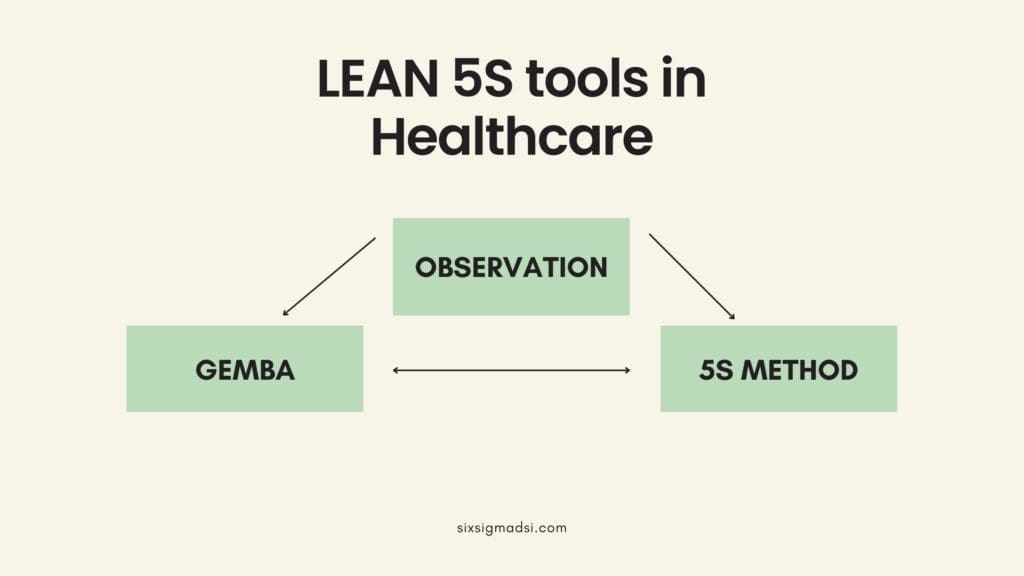Table of contents
LEAN 5S in Healthcare
The healthcare industry is changing rapidly thanks to technology. Healthcare delivery systems are shifting from traditional care to those that can use AI. Unfortunately, basic issues of quality, cost, and equity in healthcare services remain the same across all regions. Healthcare has been a constant struggle to do more with less, and often with poor quality. Profitability and sustainability are all in conflict. Many hospitals and healthcare systems have adopted new approaches to improve their operations in order to cut costs and improve quality. The environment in which processes are performed must be clean and efficient. Implementing Lean 5S tools in Healthcare provides a framework to improve efficiency on hospital floors, where people work.
What’s 5S?
Implementing Lean 5S tools in Healthcare aims to improve workplace environments. It’s an easy and highly effective method to create a better workplace environment. As it promotes safety and quality and acts as a pillar of continuous improvement within a hospital, 5S is the foundation for a safe and efficient workplace. It organizes the workplace from the functional to the physical aspect. This is why it is the foundation for any Kaizen initiative or TQM in a hospital. It is one of the most affordable Lean techniques and it is also the foundation of all other lean principles. This makes it an ideal starting point to bring the benefits of Lean to your workplace. The 5S approach can help improve the work environment at the hospital and motivate employees. The plan includes a series of actions that must be carried out with the full cooperation and support of hospital employees. 5S is an active activity that improves the work environment and delivers better service to clients.5S
Key Benefits
Improved workplace organization, reduced unwanted items, better communication, visual clarity, greater safety, happier employees, standardization, cleanliness, quality, and reductions in complaints from patients and their families, as well as a reduction in lead times and other benefits.
Why start implementing 5S in Hospitals?
- It doesn’t require understanding the complicated terminologies and concepts
- Employee engagement and teamwork are enhanced
- It empowers employees and gives them a sense of ownership
- It is straightforward, driven by logic, and natural human behavior
- Hospitals are human-intensive processes that can lead to wasteful activities. 5S can help reduce this.
- Implementing 5S correctly can save you a lot of money and increase your process efficiency.

What does “5S” Stand For?
It is named 5S because it uses five Japanese words that start with “S” to describe the five steps in this method. These words are:
Seiri – Sort
Seiton – Set in order
Seiso – Shine
Seiketsu – Standardize
Shitsuke – Sustain
1. SORT
Identify equipment, supplies, and other resources that are needed for the work in the area. Then remove any unnecessary items. Sort is a synonym for separation. It involves the removal of unwanted items from the workplace. This is the first step of 5S. Without “Sorting”, it’s impossible to move on to the next step, which is to put things in the right order. setting.
How it works
- Organize the “Big Sorting Day”
- Red tag events are a good place to start
- Get involved with the owners
- Recognize and separate unwanted items
- You can choose from indoor or outdoor
- Start the “Reduce Reuse & Recycle Concept” by combining “Sort” activities
- Take a look at the event
2. Set In Order
After Sorting, the second step in 5S is “Set”. It is the orderly arrangement and organization of everything. It is the art of arranging everything neatly, and organizing workstations to maximize efficiency and productivity. Achieving these goals requires collaboration and participation of all employees. It can be easier for everyone to live in a hospital with a neat and functional arrangement.
How it works
- Choose the places you want to set up
- Separate the areas and label everything clearly
- Expand each section one at a time to make it more comprehensive
- The visualized information can be used
- Be open to standardization in the future
3. Shine
The third stage “Shine”, is a participatory activity that maintains cleanliness in every workplace, regardless of its category or location. Each employee in the hospital is assigned a territory. They are expected to participate in the “Shine” activity. Cleaning up expensive equipment or important reports can’t be done by just the cleaners in these territories. The process owners must take an active role in cleaning their work areas. The first three “S’s” must be a part of everyday work and should be incorporated into the culture of the hospital for a 5S System.
How it works
- Everybody should take part
- Make sure you have all the necessary cleaning supplies and tools.
- Clean all equipment
- Maintenance of heavy equipment is included
- Particular emphasis is placed on the hospital waste management system
4. Standardise
The 5S “Standardize” stage is used to develop standards for the first 3S activities (i.e. Sort, Set, Shine). This stage will establish the policies and rules that support the first three steps. Remember that the 5S system can only be successful if it is followed with discipline. This step is designed to make “Set”, “Sort”, and “Shine”, part of every employee’s routine work. After standards have been established, they should be distributed to all employees via visualization, Sanitisation, and Regular Training.
How it works
- Make 3S a cultural phenomenon
- Visualization of slogans
- Safety standardization
- Standardization of color coding systems
- Standardization of checklists
- Supervisors are appreciated and recognized
- Training and documentation
5. Sustain
It is important to continue the positive changes made by 4S activities. Self-discipline and a shift in attitude and mindset is required to achieve this. This step encourages a culture of quality that will support the program and promotes self-discipline. A 5S lean tools system that is not well maintained over time will likely become less effective because of slackness from the people. A continuous improvement culture is essential in a hospital to maintain a 5S system. 5S is not the ultimate goal of the hospital’s service improvement mission. It is only the beginning point of a Kaizen culture.
How it works
- Orientation for employees
- Encourage self-discipline
- 5S contest, encourage a positive competition
- Training with hands
- Establish a culture that encourages continuous improvement
6. Safety
Each of the Lean 5S Healthcare phases includes safety.
The question is: Why do we add it as an extra step? This is because we need to pay more attention to safety issues. Safety should be given more importance in a hospital environment. This extra focus can help us not overlook potentially dangerous situations in hospitals.
How it works
- Safety in hospitals is a priority for both patients and employees.
- Particular mention is made for areas with more dangerous processes
- A well-planned safety plan can greatly reduce the chance of an accident in the hospital

Implementing 5S In A Hospital
- Inform your employees about the 5S System
- Create a plan, and get the support and approval of management
- Establish 5S zones
- Establish a 5S team and educate them. Plan the 5S System launch
- It can be done in phases. Phases 1 & 2 are the “Enablers”, and phases 3 & 4 are the actual “Results Providers”
- To see how each step fits in your hospital, examine the five S steps
- All the materials required for the launch, support, and maintenance of the 5S program are available.
- In your hospital, foster a culture that values 5S and continuous improvement
- Do an internal audit to assess the progress and benchmark the goals
- Recognize and reward employees for their efforts
- Encourage healthy competition
Hospitals can use Lean 5S tools in Healthcare to improve service quality in the eyes and hearts of their customers. Although it sounds simple and easy to implement, it is difficult to sustain the results. Management’s job is to encourage new work habits, and positive mindsets, and to empower employees to improve their workplace. The 5S implementation has resulted in increased work efficiency, better team discipline, and new enthusiasm on the hospital floors. This is directly proportional to employee satisfaction and a feeling of ownership. Hospital employees will be more capable of providing high-quality services and taking care of patients if they are happier, healthier, and less tired. Healthcare is still a human-intensive industry. 5S could be a great start to encourage continuous improvement in your hospital.
What is your experience implementing Lean 5S in Healthcare?
Let us know in the comments below.



















